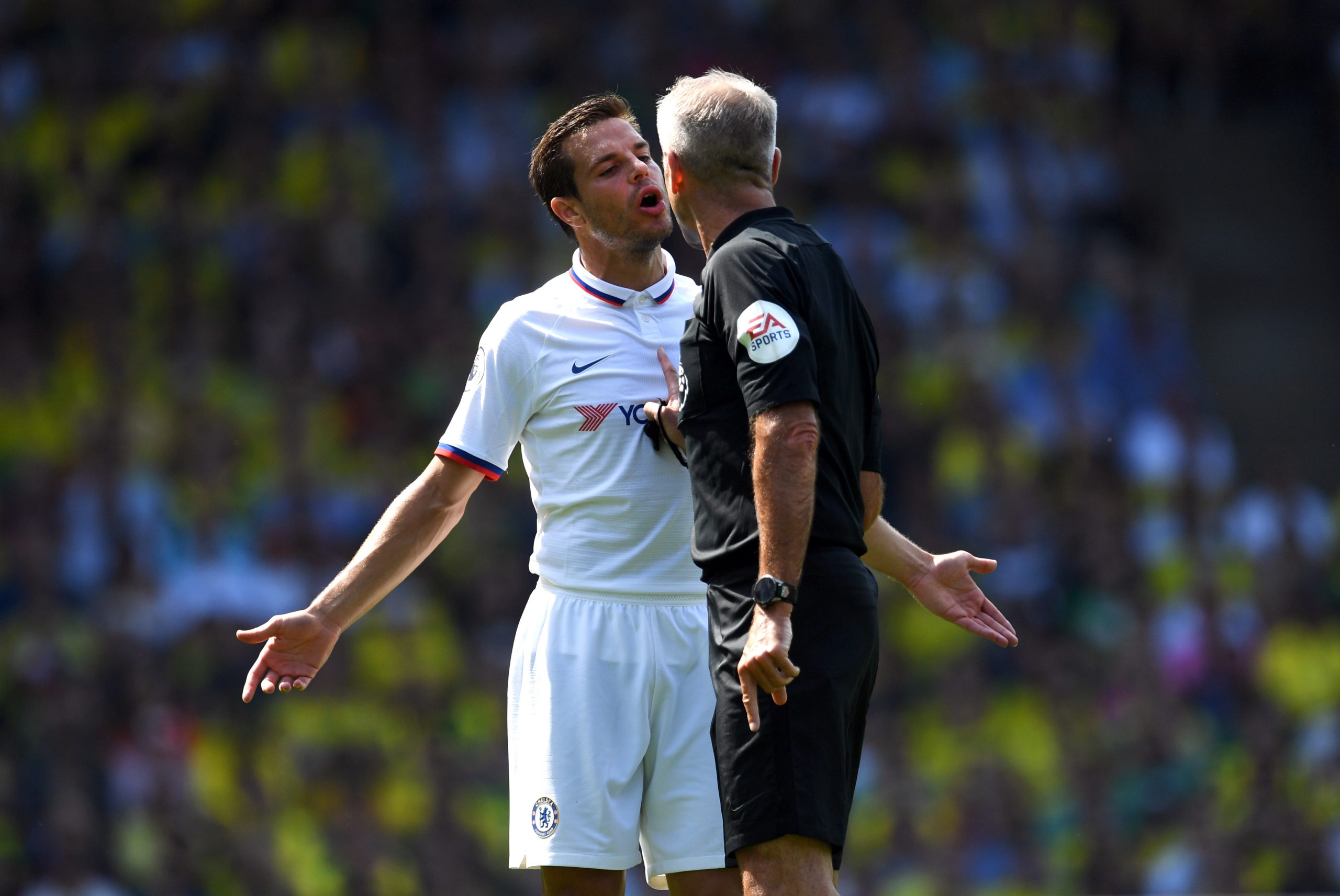Who exactly is to blame for Chelsea’s defensive woes? Over the last three years Chelsea have undergone a stunning tactical shift. A side that started out as a possession shy defensive juggernaut under Antonio Conte morphed into a wide open possession machine under Maurizio Sarri, and is now, in theory, a press heavy quick hitting operation. As tactics change, so do expectations. Players are asked to different things. Some systems will suit some players better, some will be forced to perform tasks they’re less prepared for. Their successes and failures can become more (or less) obvious to the naked eye. That brings us to César Azpilicueta. Azpilicueta is a long time Chelsea defensive stalwart. Although he was acquired as a right back, he truly turned into a star playing on the left during Jose Mourinho’s second stint at the club, and then as a right sided center back in Conte’s back three system. By the time he returned to right back under Sarri Azpilicueta hadn’t played regularly in his “natural” position for five seasons. The challenge in assessing Azpilicueta is that while he has been ever present for Chelsea, Chelsea have changed so much that separating out possible decline in the 30-year-old from a shifting system is hard. The shift from Conte to Sarri emphasizes just how drastically tactics can change. In each of those years Chelsea conceded 0.88 expected goals and between nine and ten shots per math. But, under Conte they played 577 passes per match and allowed 469, while under Sarri they played 695 and conceded 412. So opponents had the ball significantly less, but turned that possession into the exact same number of expected goals. This isn’t shocking. The primary defensive weapon Sarri deployed was always having the ball. The team was extremely vulnerable when they didn’t have, it’s just those times were relatively few and far between. Conte on the other hand made sure his team was not vulnerable out of possession, but would more readily concede possession to do so. This season, through four games, Chelsea really are worse defensively, not just different. They’re conceding 1.07 xG per match, despite conceding a similar number of shots. They’ve also played 592 passes and conceded 472. They aren’t quite the possession machine that they were under Sarri, but they’re not far off. The problem is that not only are they conceding shots quickly when they lose it, but they’re conceding really good shots (even if more of them have gone in than you might predict). 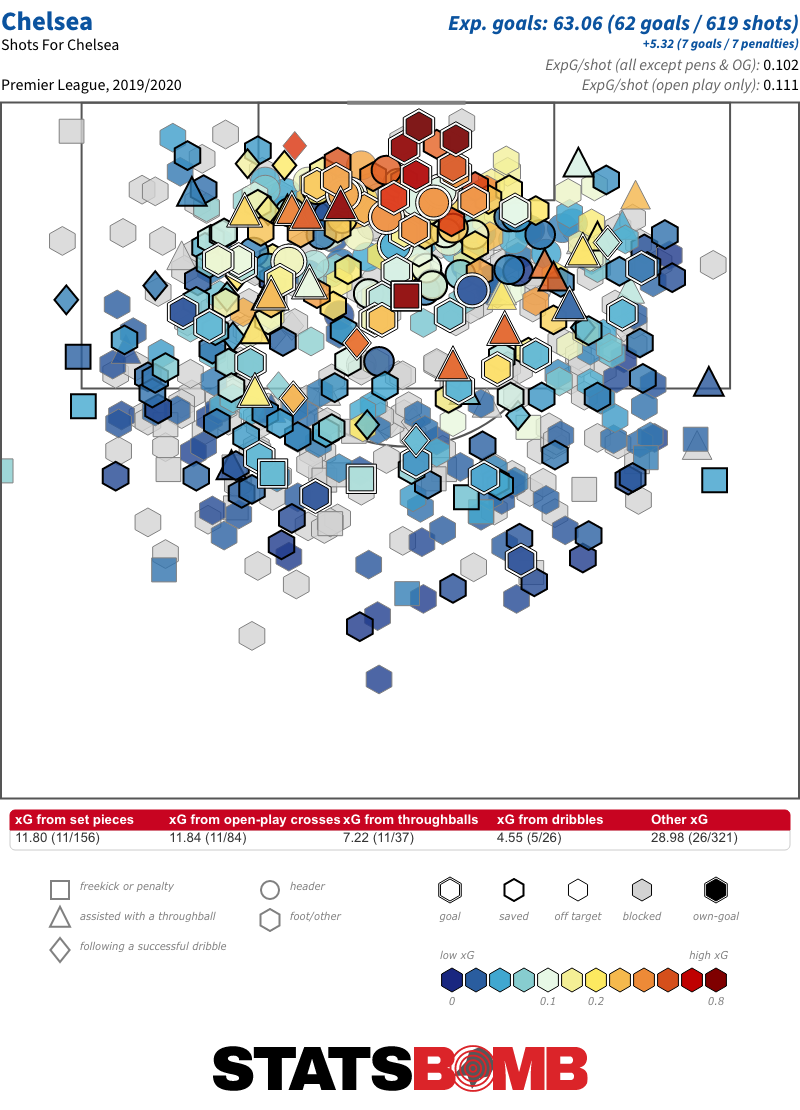 Give that, it’s at least fair to wonder if Azpilicueta is declining. The team’s possession stats haven’t change a tremendous amount, nor have the number of shots they’re conceding, it’s just that the quality of chances are increasing. A simple explanation would be the team’s reliable defender getting old and less reliable. The data, however, hints at a more complicated story. Let’s start with old reliable, the radar, and compare last season and this season.
Give that, it’s at least fair to wonder if Azpilicueta is declining. The team’s possession stats haven’t change a tremendous amount, nor have the number of shots they’re conceding, it’s just that the quality of chances are increasing. A simple explanation would be the team’s reliable defender getting old and less reliable. The data, however, hints at a more complicated story. Let’s start with old reliable, the radar, and compare last season and this season. 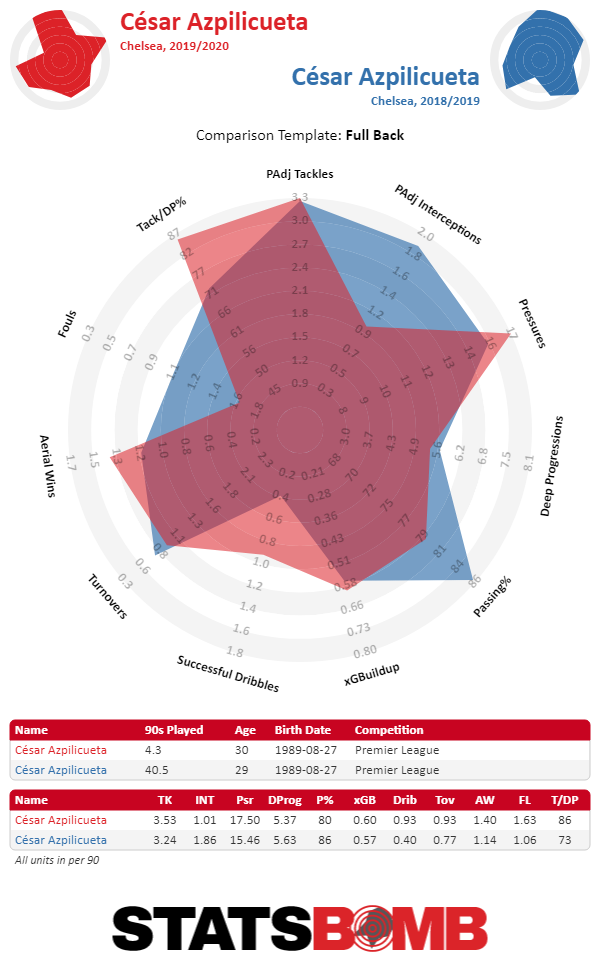 The radars are different, but this year’s version sure doesn’t seem bad. There are a couple of particularly notable trends, however. First, he’s doing a lot less intercepting of the ball, dropping from 1.86 per 90 minutes to 1.01. Second, he’s not only doing more tackling, but, on a percentage basis he’s doing it more efficiently than last season, with his possession adjusted tackles per 90 ticking upwards to 3.53 from 3.24 and his tackles per dribbled past % going from 73% to 86%. So, he’s getting dribbled past less of the time he tries to tackle this season, despite the fact that he’s actually doing more tackling. Then there’s the fact that Azpilicueta’s defensive actions have actually come higher up the field this season than last. He’s frequently stepping into the opposition half to pressure the opposition and try and break up play.
The radars are different, but this year’s version sure doesn’t seem bad. There are a couple of particularly notable trends, however. First, he’s doing a lot less intercepting of the ball, dropping from 1.86 per 90 minutes to 1.01. Second, he’s not only doing more tackling, but, on a percentage basis he’s doing it more efficiently than last season, with his possession adjusted tackles per 90 ticking upwards to 3.53 from 3.24 and his tackles per dribbled past % going from 73% to 86%. So, he’s getting dribbled past less of the time he tries to tackle this season, despite the fact that he’s actually doing more tackling. Then there’s the fact that Azpilicueta’s defensive actions have actually come higher up the field this season than last. He’s frequently stepping into the opposition half to pressure the opposition and try and break up play. 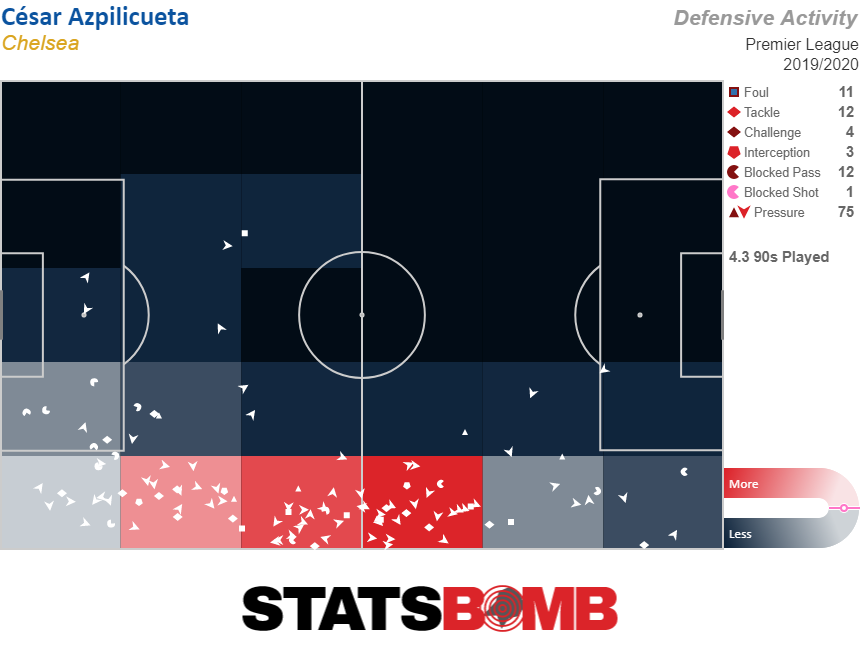 Last season, he was able to stay somewhat more in reserve and intervene primarily in his own defensive half.
Last season, he was able to stay somewhat more in reserve and intervene primarily in his own defensive half. 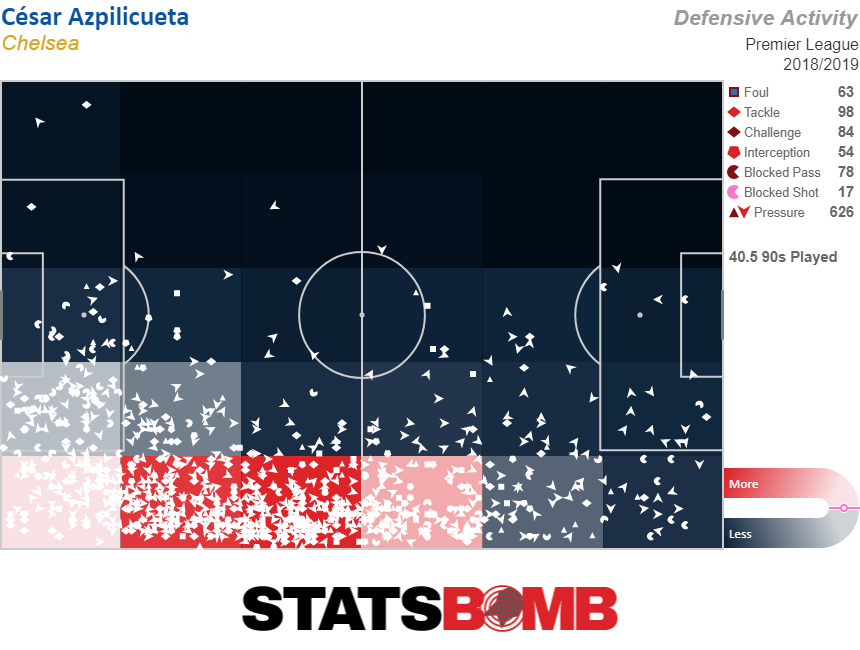 And finally, we can look at what opponents do with the ball when attacking Chelsea. Here are all the times that Chelsea’s opponent have moved the ball into the penalty box from open play, either by passing the ball in, or carrying it.
And finally, we can look at what opponents do with the ball when attacking Chelsea. Here are all the times that Chelsea’s opponent have moved the ball into the penalty box from open play, either by passing the ball in, or carrying it. 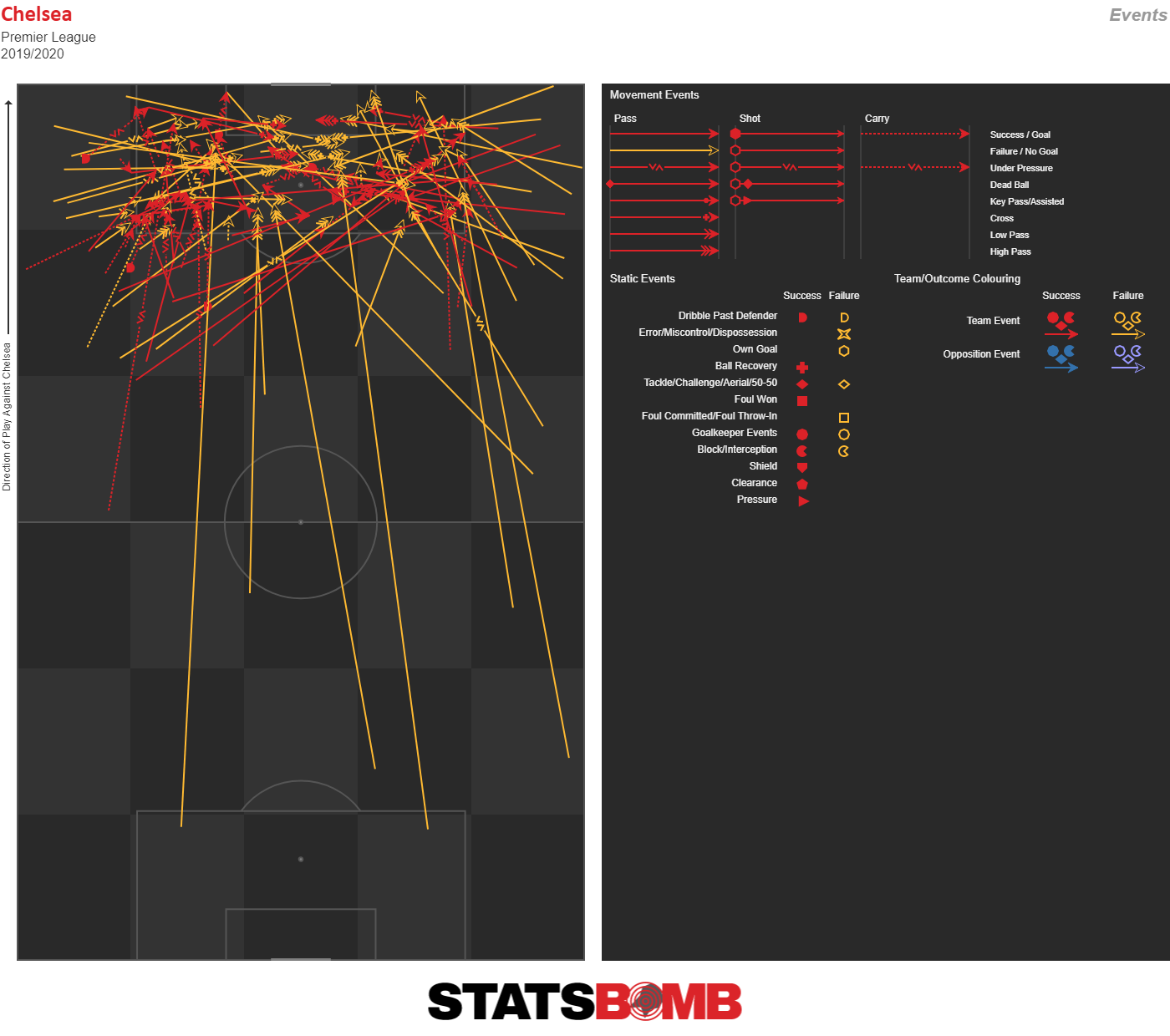 Azpilicueta’s side of the penalty area does not seem to be more under siege than his counterpart on the left. However, if we drill down a little bit, something interesting appears. If we look only at successful plays that are unpressured, here’s what we find.
Azpilicueta’s side of the penalty area does not seem to be more under siege than his counterpart on the left. However, if we drill down a little bit, something interesting appears. If we look only at successful plays that are unpressured, here’s what we find. 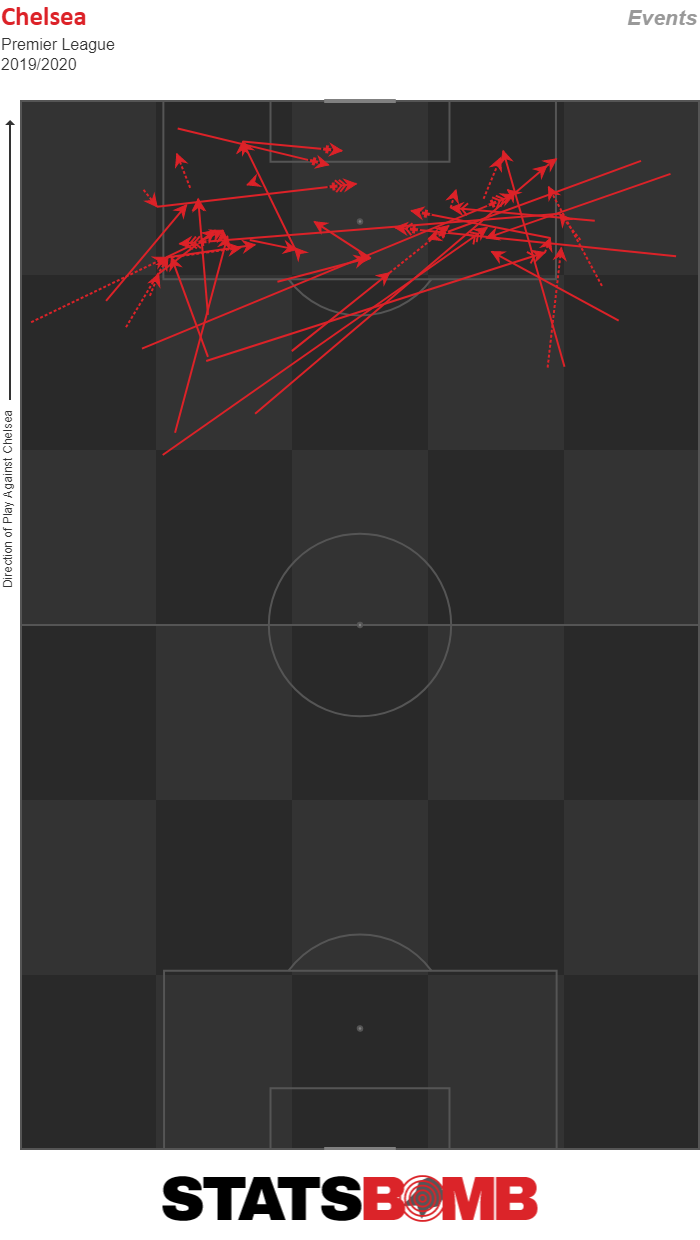 There are a number of instances where Chelsea have allowed a successful, unpressured pass from their right defensive inside channel to the left side of the box. That left defensive side of the box has been targeted from the left wing as well. In fact, the left side of the box seems to be under assault from unpressured actions significantly more than the right side is. If we look at successful pressured actions, however, we see Azpilicueta’s side light up.
There are a number of instances where Chelsea have allowed a successful, unpressured pass from their right defensive inside channel to the left side of the box. That left defensive side of the box has been targeted from the left wing as well. In fact, the left side of the box seems to be under assault from unpressured actions significantly more than the right side is. If we look at successful pressured actions, however, we see Azpilicueta’s side light up. 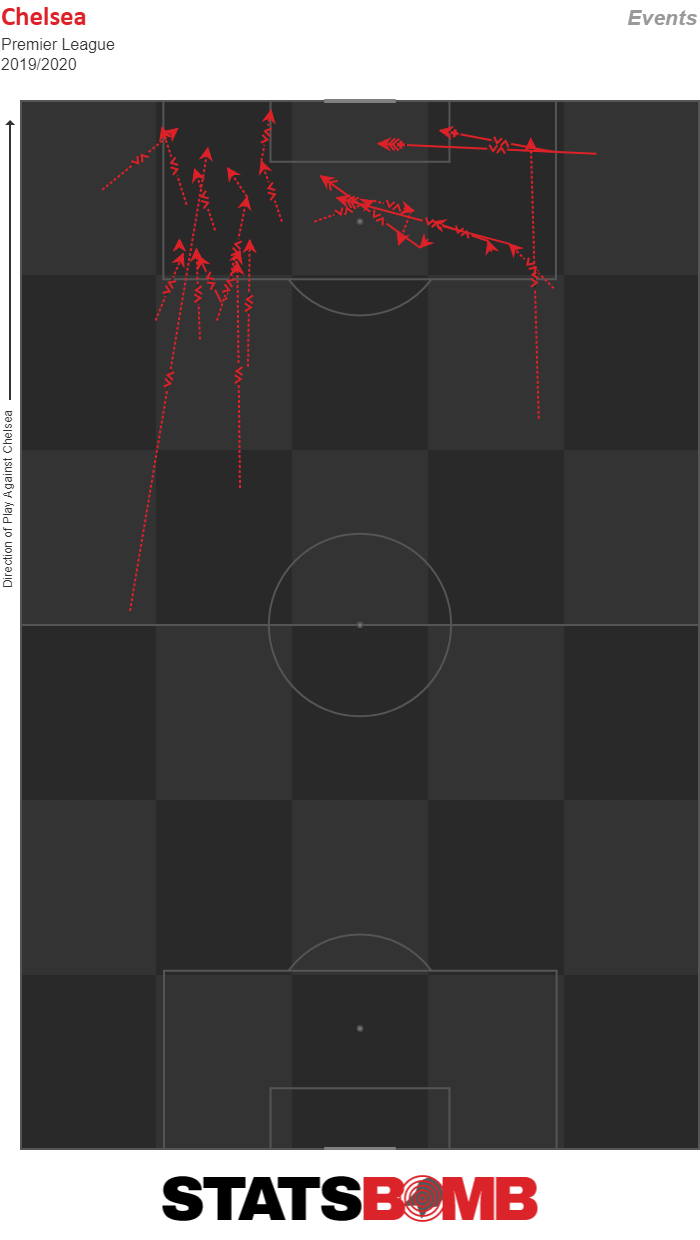 Putting all those pieces together into a coherent story is tricky. One thing that seems clear is that Azpilicueta is being tasked with an incredibly difficult job. The combination of strong tackling numbers with the dip in interceptions and more aggressive positioning suggests that he’s frequently being left on an island and forced to deal with attackers running at him in space. While he’s largely successful at holding down that flank, he’s not perfect. He’s largely able to harry attackers and pressure opponents as they attempt to get to the byline, but has been vulnerable when players cut back to the inside and play crosses across the box (like the one that led to Kurt Zouma’s game tying own goal against Sheffield United). On one level, those kinds of outcomes tend to be what happens when a player makes the best of a bad situation. Azpilicueta’s slowing down attacks and forcing wingers to turn back inside and either face defensive help from his teammates, or play lower probability balls than they would be if they wiggled free. But, it’s also fair to ask, with the higher positioning seemingly required of him this season, would a more athletic player (somebody like 19-year-old already in the team of the season in the Championship last year for Wigan Reece James) be effectively preventing these situations to begin with by preventing the passes out to the wing in the first place? Finally, there’s the question of the rest of the Chelsea defense. It’s a lot less dangerous to force a player to check back inside if he’s running into N'Golo Kanté than it is if it’s only Jorginho waiting on him. Then there’s Kurt Zouma as the left sided central defender who teams appear to be picking on relentlessly. It’s possible that if Antonio Rüdiger returns from injury and takes his place (either directly or by coming in on the right and allowing another defender to slide over), those crossfield balls will start seeming less dangerous. Ultimate it’s easy to see the things Azpilicueta has struggled to do this season. He’s been isolated defensively, and teams have been attacking quickly and directly down the flank to take advantage. Azpiicueta has, in those circumstances reliably made the best of bad situations, but sometimes that hasn’t been good enough, and it’s fair to ask if a younger version of the Spanish defender might have had the range to prevent those situations from developing to begin with. But, it’s also fair to ask whether Azpilicueta is being let down by his teammates and whether all those moments when he forces players to check inside, or slows them down without stopping them should result in his teammates picking up the slack more than they are. That’s good news for Chelsea. It means that as some of their better defenders come back, Azpilicueta will likely appear to be improving. It’s also good news for Azpilicueta, because it means that at 30, he’s not nearly as vulnerable as he seems at times. If he’s not good enough for the role he’s being asked to play at times, it’s because that role is incredibly difficult. Better defensive players around him will ease that burden. Those players will make the job of playing right back for Chelsea easier, rather than requiring that the team go out and find a better to play right back. Header image courtesy of the Press Association
Putting all those pieces together into a coherent story is tricky. One thing that seems clear is that Azpilicueta is being tasked with an incredibly difficult job. The combination of strong tackling numbers with the dip in interceptions and more aggressive positioning suggests that he’s frequently being left on an island and forced to deal with attackers running at him in space. While he’s largely successful at holding down that flank, he’s not perfect. He’s largely able to harry attackers and pressure opponents as they attempt to get to the byline, but has been vulnerable when players cut back to the inside and play crosses across the box (like the one that led to Kurt Zouma’s game tying own goal against Sheffield United). On one level, those kinds of outcomes tend to be what happens when a player makes the best of a bad situation. Azpilicueta’s slowing down attacks and forcing wingers to turn back inside and either face defensive help from his teammates, or play lower probability balls than they would be if they wiggled free. But, it’s also fair to ask, with the higher positioning seemingly required of him this season, would a more athletic player (somebody like 19-year-old already in the team of the season in the Championship last year for Wigan Reece James) be effectively preventing these situations to begin with by preventing the passes out to the wing in the first place? Finally, there’s the question of the rest of the Chelsea defense. It’s a lot less dangerous to force a player to check back inside if he’s running into N'Golo Kanté than it is if it’s only Jorginho waiting on him. Then there’s Kurt Zouma as the left sided central defender who teams appear to be picking on relentlessly. It’s possible that if Antonio Rüdiger returns from injury and takes his place (either directly or by coming in on the right and allowing another defender to slide over), those crossfield balls will start seeming less dangerous. Ultimate it’s easy to see the things Azpilicueta has struggled to do this season. He’s been isolated defensively, and teams have been attacking quickly and directly down the flank to take advantage. Azpiicueta has, in those circumstances reliably made the best of bad situations, but sometimes that hasn’t been good enough, and it’s fair to ask if a younger version of the Spanish defender might have had the range to prevent those situations from developing to begin with. But, it’s also fair to ask whether Azpilicueta is being let down by his teammates and whether all those moments when he forces players to check inside, or slows them down without stopping them should result in his teammates picking up the slack more than they are. That’s good news for Chelsea. It means that as some of their better defenders come back, Azpilicueta will likely appear to be improving. It’s also good news for Azpilicueta, because it means that at 30, he’s not nearly as vulnerable as he seems at times. If he’s not good enough for the role he’s being asked to play at times, it’s because that role is incredibly difficult. Better defensive players around him will ease that burden. Those players will make the job of playing right back for Chelsea easier, rather than requiring that the team go out and find a better to play right back. Header image courtesy of the Press Association
2019
Is Chelsea's César Azpilicueta bad now?
By Kevin Lawson
|
September 2, 2019
